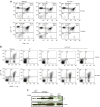A novel model of SCID-X1 reconstitution reveals predisposition to retrovirus-induced lymphoma but no evidence of gammaC gene oncogenicity
- PMID: 19337236
- PMCID: PMC2835181
- DOI: 10.1038/mt.2009.59
A novel model of SCID-X1 reconstitution reveals predisposition to retrovirus-induced lymphoma but no evidence of gammaC gene oncogenicity
Erratum in
- Mol Ther. 2009 Aug;17(8):1483. Philbey, Adrain [corrected to Philbey, Adrian]; Thrasher, Adrain J [corrected to Thrasher, Adrian J]
Abstract
The emergence of leukemia following gene transfer to restore common cytokine receptor gamma chain (gammaC) function in X-linked severe combined immunodeficiency (SCID-X1) has raised important questions with respect to gene therapy safety. To explore the risk factors involved, we tested the oncogenic potential of human gammaC in new strains of transgenic mice expressing the gene under the control of the CD2 promoter and locus control region (LCR). These mice demonstrated mildly perturbed T-cell development, with an increased proportion of thymic CD8 cells, but showed no predisposition to tumor development even on highly tumor prone backgrounds or after gamma-retrovirus infection. The human CD2-gammaC transgene rescued T and B-cell development in gammaC(-/-) mice but with an age-related delay, mimicking postnatal reconstitution in SCID-X1 gene therapy subjects. However, we noted that gammaC(-/-) mice are acutely susceptible to murine leukemia virus (MLV) leukemogenesis, and that this trait was not corrected by the gammaC transgene. We conclude that the SCID-X1 phenotype can be corrected safely by stable ectopic expression of gammaC and that the transgene is not significantly oncogenic when expressed in this context. However, an underlying predisposition conferred by the SCID-X1 background appears to collaborate with insertional mutagenesis to increase the risk of tumor development.
Figures






Similar articles
-
Lymphomagenesis in SCID-X1 mice following lentivirus-mediated phenotype correction independent of insertional mutagenesis and gammac overexpression.Mol Ther. 2010 May;18(5):965-76. doi: 10.1038/mt.2010.50. Epub 2010 Mar 30. Mol Ther. 2010. PMID: 20354504 Free PMC article.
-
A modified γ-retrovirus vector for X-linked severe combined immunodeficiency.N Engl J Med. 2014 Oct 9;371(15):1407-17. doi: 10.1056/NEJMoa1404588. N Engl J Med. 2014. PMID: 25295500 Free PMC article. Clinical Trial.
-
Gene therapy model of X-linked severe combined immunodeficiency using a modified foamy virus vector.PLoS One. 2013 Aug 21;8(8):e71594. doi: 10.1371/journal.pone.0071594. eCollection 2013. PLoS One. 2013. PMID: 23990961 Free PMC article.
-
Gene therapy for severe combined immunodeficiencies and beyond.J Exp Med. 2020 Jan 6;217(2):e20190607. doi: 10.1084/jem.20190607. J Exp Med. 2020. PMID: 31826240 Free PMC article. Review.
-
[Analysis of gammac-dependent cytokines-mediated immunoregulation].Rinsho Byori. 2007 Jan;55(1):51-8. Rinsho Byori. 2007. PMID: 17319491 Review. Japanese.
Cited by
-
Evaluating risks of insertional mutagenesis by DNA transposons in gene therapy.Transl Res. 2013 Apr;161(4):265-83. doi: 10.1016/j.trsl.2012.12.005. Epub 2013 Jan 10. Transl Res. 2013. PMID: 23313630 Free PMC article. Review.
-
Concise review: lessons learned from clinical trials of gene therapy in monogenic immunodeficiency diseases.Stem Cells Transl Med. 2014 May;3(5):636-42. doi: 10.5966/sctm.2013-0206. Epub 2014 Mar 28. Stem Cells Transl Med. 2014. PMID: 24682287 Free PMC article. Review.
-
Mouse transplant models for evaluating the oncogenic risk of a self-inactivating XSCID lentiviral vector.PLoS One. 2013 Apr 23;8(4):e62333. doi: 10.1371/journal.pone.0062333. Print 2013. PLoS One. 2013. PMID: 23626802 Free PMC article.
-
Gene Therapy for X-Linked Severe Combined Immunodeficiency: Where Do We Stand?Hum Gene Ther. 2016 Feb;27(2):108-16. doi: 10.1089/hum.2015.137. Hum Gene Ther. 2016. PMID: 26790362 Free PMC article. Review.
-
Evolving Gene Therapy in Primary Immunodeficiency.Mol Ther. 2017 May 3;25(5):1132-1141. doi: 10.1016/j.ymthe.2017.03.018. Epub 2017 Mar 31. Mol Ther. 2017. PMID: 28366768 Free PMC article. Review.
References
-
- Cavazzana-Calvo M, Hacein-Bey S, de Saint Basile G, Gross F, Yvon E, Nusbaum P, et al. Gene therapy of human severe combined immunodeficiency (SCID)-X1 disease. Science. 2000;288:669–672. - PubMed
-
- Hacein-Bey-Abina S, von Kalle C, Schmidt M, Le Deist F, Wulffraat N, McIntyre E, et al. A serious adverse event after successful gene therapy for X-linked severe combined immunodeficiency. N Engl J Med. 2003;348:255–256. - PubMed
-
- Rabbitts TH, Bucher K, Chung G, Grutz G, Warren A., and , Yamada Y. The effect of chromosomal translocations in acute leukemias: the LMO2 paradigm in transcription and development. Cancer Res. 1999;59:1794s–1798s. - PubMed
Publication types
MeSH terms
Substances
Grants and funding
LinkOut - more resources
Full Text Sources
Medical
Research Materials

